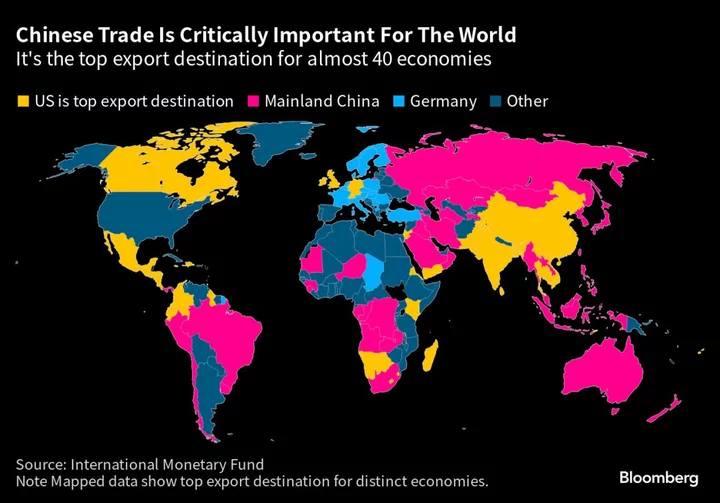China is no longer set to eclipse the US as the world’s biggest economy soon, and it may never consistently pull ahead to claim the top spot as the nation’s confidence slump becomes more entrenched.
That’s according to Bloomberg Economics, which now forecasts it will take until the mid-2040s for China’s gross domestic product to exceed that of the US — and even then, it will happen by “only a small margin” before “falling back behind.” Before the pandemic, they expected China to take and hold pole position as early as the start of next decade.
“China is down-shifting onto a slower growth path sooner than we expected,” the Bloomberg Economists wrote in a Tuesday research note. “The post-Covid rebound has run out of steam, reflecting a deepening property slump and fading confidence in Beijing’s management of the economy. Weak confidence risks becoming entrenched — resulting in an enduring drag on growth potential.”
The economists now see growth in China’s economy — the world’s second largest — slowing to 3.5% in 2030 and to near 1% by 2050. That’s lower than prior projections of 4.3% and 1.6%, respectively.
China’s economy expanded 3% last year, one of its slowest rates of growth in decades as pandemic controls and a property crisis battered the country. Its eventual reopening provided hope the economy would bounce back this year.
But the recovery has lost steam as exports tumble and the real estate slump deepens. A private gauge of the services sector showed activity easing last month as people held back from spending. Economists surveyed by Bloomberg have also been downgrading their growth forecasts for 2024 further below 5%.
Read more: New Forecast Says GDP May Never Hold No. 1 Spot
The revised outlook comes as the world reconsiders how to work with a China that may be approaching a peak in power, even if it’s not in decline.
The US and Group of Seven nations are increasingly looking at evidence of deep-seated structural problems in China, seeing opportunities that ultimately will strengthen the West’s hand against a weakening geopolitical competitor while also considering ripple effects from the slowdown. This year’s snags already are roiling commodities and stocks.
The country is also contending with deeper, longer-term challenges. China clocked its first population drop last year since the 1960s, raising concerns about weakening productivity. Regulatory crackdowns have also hit confidence, as have geopolitical tensions with the US and other Western governments.
By contrast, the US appears to be in better shape than what many economists predicted just a few months ago. A strong labor market, sturdy consumer spending and moderating inflation have fueled confidence in the economy’s ability to avoid a recession for now. Goldman Sachs Group Inc. now sees a 15% chance the US will slide into recession, down from 20% previously.
Read more: Goldman Cuts US Recession Chances to 15% on Improved Inflation
Bloomberg Economics estimates potential US growth at 1.7% in 2022-2023, with long-term forecasts showing a gradual drifting down to 1.5% by 2050.
Bloomberg’s economists said optimism for China’s growth in the medium-term remains grounded in the “enormous size of the economy, significant space to catch up to global technology leaders and the development focus of the government.” But they noted those drivers are “operating with diminished force.”
--With assistance from Jenni Marsh.
(Updates with Goldman’s forecast in 10th paragraph)

